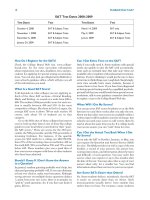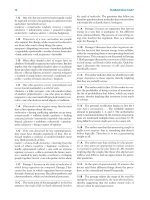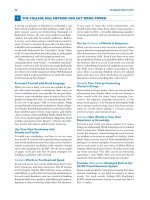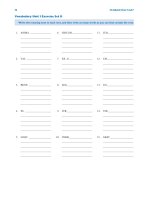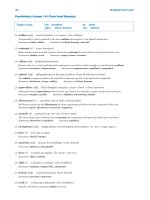Sat - MC Grawhill part 5 potx
Bạn đang xem bản rút gọn của tài liệu. Xem và tải ngay bản đầy đủ của tài liệu tại đây (213.3 KB, 10 trang )
3 3 333 3
Questions 19–24 are based on the following passage.
The following is an excerpt from a memoir of
Richard Feynman, a Nobel Prize–winning physicist,
in which he describes the experience of having an
artist friend named Jerry teach him to draw.
I promised to work, but still bet that he couldn’t
teach me to draw. I wanted very much to
learn to draw, for a reason that I kept to
myself: I wanted to convey an emotion I have
about the beauty of the world. It’s difficult to
describe because it’s an emotion. It’s analo-
gous to the feeling one has in religion that has
to do with a god that controls everything in
the universe: there’s a generality aspect that
you feel when you think about how things
that appear so different and behave so differ-
ently are all run “behind the scenes” by the
same organization, the same physical laws.
It’s an appreciation of the mathematical
beauty of nature, of how she works inside; a
realization that the phenomena we see result
from the complexity of the inner workings
between atoms; a feeling of how dramatic and
wonderful it is. It’s a feeling of awe—of scien-
tific awe—which I felt could be communicated
through a drawing to someone who had also
had this emotion. It could remind him, for a
moment, of this feeling about the glories of
the universe.
Jerry turned out to be a very good teacher. He
told me first to go home and draw anything.
So I tried to draw a shoe; then I tried to draw
a flower in a pot. It was a mess!
The next time we met I showed him my
attempts: “Oh, look!” he said. “You see, around
in back here, the line of the flower pot doesn’t
touch the leaf.” (I had meant the line to come
up to the leaf.) “That’s very good. It’s a way of
showing depth. That’s very clever of you.”
“And the fact that you don’t make all the
lines the same thickness (which I didn’t mean
to do) is good. A drawing with all the lines the
same thickness is dull.” It continued like that:
everything that I thought was a mistake, he
used to teach me something in a positive way.
He never said it was wrong; he never put me
down. So I kept on trying, and I gradually got
a little bit better, but I was never satisfied.
19. In line 13, the word “organization” most nearly
means
(A) corporation
(B) rules of physics
(C) social group
(D) arrangement of objects
(E) system of emotional expression
20. Which of the following experiences is closest to
what the author describes as “dramatic and
wonderful” (lines 18–19)?
(A) proving a physical law
(B) creating a beautiful sculpture
(C) appreciating the power of physical laws
in nature
(D) teaching another person how to play an
instrument
(E) seeing a masterful painting for the first
time
21. What assumption does the author make about
the appreciation of art?
(A) It comes only through the experience of
creating art.
(B) It is enhanced by having experiences
similar to those that inspired the artist.
(C) It is not as important as the appreciation
of science.
(D) It is difficult for a scientist.
(E) It requires an understanding of the
historical period in which the piece
was created.
30 McGRAW-HILL’S SAT
Line
5
10
15
20
25
30
35
40
Excerpted from “Surely You’re Joking Mr. Feynman!”:
Adventures of A Curious Character by Richard Feynman
as told to Ralph Leighton. Copyright © 1985 by
Richard P. Feynman and Ralph Leighton.
Reprinted with permission of W.W. Norton & Company, Inc.
GO ON TO THE NEXT PAGE
CHAPTER 2 / DIAGNOSTIC SAT 31
3 3 333 3
22. If Jerry is really a “very good teacher” (line 25) in
the way that the author suggests, what would he
most likely have done if the author had drawn the
flower pot with lines of all the same thickness?
(A) Jerry would have shown the author how
to vary the thickness of his lines.
(B) Jerry would have shown the author
examples of how line thickness affects
the quality of a drawing.
(C) Jerry would have mentioned that the
drawing was dull, but could be made
more lively with color.
(D) Jerry would have found something
positive elsewhere in the drawing.
(E) Jerry would have made the author
re-do the drawing.
23. The author suggests that the “way of showing
depth” (lines 33–34) is actually
(A) unintentional
(B) unattractive
(C) difficult to accomplish
(D) not characteristic of true art
(E) a reflection of the author’s theory of
nature
24. In what way was the author “never satisfied”
(line 43)?
(A) He was never able to fully appreciate
great art.
(B) He was never able to draw a realistic
flower pot.
(C) He was not able to replicate his teacher’s
talent for emphasizing the positive in his
students.
(D) He never fully appreciated the talent of
his teacher.
(E) He was never able to convey adequately
his feelings about the beauty of the
world.
STOP
If you finish before time is called, you may
check your work on this section only. Do not
turn to any other section of the test.
A
C D
E
B
GO ON TO THE NEXT PAGE
4 4 444 4
SECTION 4
Time—25 minutes
35 questions
Turn to Section 4 of your answer sheet to answer the questions in this section.
Directions: For each question in this section, select the best answer from among the choices given and
fill in the corresponding circle on the answer sheet.
The following sentences test correctness and
effectiveness of expression. Part of each sen-
tence or the entire sentence is underlined;
beneath each sentence are five ways of phras-
ing the underlined material. Choice A repeats
the original phrasing; the other four choices
are different. Select the choice that completes
the sentence most effectively.
In making your selection, follow the require-
ments of standard written English; that is, pay
attention to grammar, choice of words, sentence
construction, and punctuation. Your selection
should result in the most effective sentence—
clear and precise, without awkwardness or
ambiguity.
EXAMPLE:
The children couldn’t hardly believe their eyes
.
(A) couldn’t hardly believe their eyes
(B) could hardly believe their eyes
(C) would not hardly believe their eyes
(D) couldn’t nearly believe their eyes
(E) couldn’t hardly believe his or her eyes
1. The anthology contains mostly the work of
modern poets, but which includes a few signif
-
icant older works as well.
(A) which includes a few significant older
works as well
(B) it includes a few significant older works
as well
(C) also it contains a few significant older
works as well
(D) as well, it also includes a few significant
older works
(E) which also include a few significant older
works
2. The coach worked long and hard into the night for
preparing the team’s strategy for the next game.
(A) for preparing the team’s strategy
(B) in preparing the team’s strategy
(C) for the preparation of the team’s strategy
(D) in order for proper preparation of the
team’s strategy
(E) to prepare the team’s strategy
3. Although usually unflappable even in front of a
crowd, Carla’s anxiety overwhelmed her
during
the recital.
(A) Carla’s anxiety overwhelmed her
(B) her anxiety overwhelmed Carla
completely
(C) Carla being overwhelmed by anxiety
(D) Carla was overwhelmed by anxiety
(E) nevertheless Carla’s anxiety was
overwhelming
32 McGRAW-HILL’S SAT
CHAPTER 2 / DIAGNOSTIC SAT 33
GO ON TO THE NEXT PAGE
4 4 444 4
8. The spectators watched agape, they could not
believe what they were seeing on the playing field.
(A) agape, they could not believe
(B) agape having not believed
(C) agape, for the reason that they could not
believe
(D) agape: they could not believe
(E) agape, therefore they could not believe
9. The evidence for clairvoyance has never been
persuasive, and many people continue to
believe that it is a widespread phenomenon.
(A) persuasive, and many people continue
to believe
(B) persuasive; nevertheless, many people
continue to believe
(C) persuasive, so many people continue to
believe
(D) persuasive: and people continue to
believe anyway
(E) persuasive, which is why people
continue to believe
10. The strange theories that explain the atom
reveals how deeply the common and the bizarre
are entwined in the physical world.
(A) reveals how deeply the common and the
bizarre are entwined
(B) reveal how common the entwining of the
bizarre is
(C) reveals the deep bizarre common
entwining
(D) reveal how the common and the bizarre
are so entwined deeply
(E) reveal how deeply the common and the
bizarre are entwined
11. The transportation board announced their
anonymous approval of the new contract at the
press conference that afternoon.
(A) their anonymous approval
(B) its anonymous approval
(C) their unanimous approval
(D) its unanimous approval
(E) about its unanimous approval
4. Those students who sit through her lectures day
after day, having been numbed into thinking that
history could never be even remotely interesting.
(A) day after day, having been numbed into
thinking
(B) day after day being numbed into think-
ing
(C) day after day have been numbed into
thinking
(D) day after day of being numbed into
thinking
(E) day after day of having been numbed
into thinking
5. Swimming in the deepest part of the lake, the
current pushed Justine farther from shore.
(A) the current pushed Justine farther from
shore
(B) Justine by the current was pushed
farther from shore
(C) Justine was pushed farther from shore
by the current
(D) the current’s push made sure that
Justine moved farther from shore
(E) the push of the current moved Justine
farther from shore
6. Writing a good twenty-page research paper is
more difficult than when you have to write
two
good ten-page papers.
(A) when you have to write
(B) when one must write
(C) the writing of
(D) writing
(E) one’s writing of
7. If we had not stopped for gas
, we probably
would have arrived in time for the movie.
(A) If we had not stopped for gas
(B) If we would not have stopped for gas
(C) If we didn’t have stopped for gas
(D) Because we had stopped for gas
(E) If not for having been stopped for gas
GO ON TO THE NEXT PAGE
34 McGRAW-HILL’S SAT
4 4 444 4
The following sentences test your ability to
recognize grammar and usage errors. Each
sentence contains either a single error or no
error at all. No sentence contains more than
one error. The error, if there is one, is under-
lined and lettered. If the sentence contains an
error, select the one underlined part that must
be changed to make the sentence correct. If the
sentence is correct, select choice E. In choos-
ing answers, follow the requirements of stan-
dard written English.
EXAMPLE:
By the time they reached
the halfway point
A
in the race
, most of the runners hadn’t hardly
BC D
begun to hit their stride. No error
E
14. Surprisingly
absent from the game were the
AB
crowd’s customary
taunting of the opposing
CD
players. No error
E
15. Much
of the class time was dedicated to
AB
discussing those theories that seemed to be
C
most commonly misconstrued
by the students.
No error
DE
16. The refraction of light as it passes from
air
A
into a denser medium
like water or glass
B
often produce
interesting kaleidoscopic
C
effects
. No error
DE
17. Of the two films that made
money
A
for the studio
this year, the least expensive
BC
garnered the more favorable
reviews.
D
No error
E
12. The reporters failed to notice the discrepancies
A
in the report that the Congressman presented,
because his staff and him
had successfully
BC
diverted the media’s attention to other issues.
D
No error
E
13. The Warren family, whose ancestors
founded
the town over three hundred years
AB
ago, have ran
the general store for seven
C D
generations. No error
E
A
C D
E
B
CHAPTER 2 / DIAGNOSTIC SAT 35
GO ON TO THE NEXT PAGE
4 4 444 4
18. Having invested so much effort in getting
her team so far
in the tournament,
AB
Coach Moran could hardly be blamed for
reacting so emotional
to the foul called on
CD
her player in the waning seconds of the
game. No error
E
19. To its most eminent proponents, anarchism
implies
not a desire for lawlessness or
A
chaos, but rather it is
a respect for the ability of
BC
individuals to manage
their own affairs
D
justly without the intervention of a
government. No error
E
20. The senate adopted new rules to prevent
representatives from serving
on a committee
A
while at the same time
maintaining an
B
interest in any company
that conducts
C
business that is affected
by that committee’s
D
decisions. No error
E
21. The labor coalition, which consists
of
A
representatives from all of the skilled labor
unions, have expressed
concern about the
BC
new hiring policies enacted by
the board.
D
No error
E
22. Most cognitive scientists now believe
that
A
the way the human brain stores information
B
is different
in many significant ways from
C
a computer hard drive
. No error
DE
23. The museum, which has sponsored
free
A
programs in the arts for city children since
the late 1960s, was cited
by the mayor for
BC
their
many civic contributions. No error
DE
24. When given the choice
, Harlow’s monkeys
A
clearly preferred the warmer, cloth-covered
surrogate mother more than
the wire
B
surrogate, even when
the latter was able
C
to provide
them with nourishment.
D
No error
E
25. Although both films accurately depict
the
A
horrors of fi
ghting on the front lines, Saving
B
Private Ryan is by far
the most graphic.
CD
No error
E
GO ON TO THE NEXT PAGE
36 McGRAW-HILL’S SAT
4 4 444 4
26. The debate team, which included
A
Emma and I
, was stuck on the bus for
BC
more than two
hours. No error
DE
27. By the time he reached
the island, David
A
had already swam
further than anyone
BC
else ever had
. No error
DE
28. Far from
being a liberal fanatic, Davis
A
actually espouses
very conservative
B
views on
social and economic issues.
CD
No error
E
29. For building
vocabulary skills, students
A
should try to
speak and write new words in
B
appropriate contexts
, rather than merely
CD
memorizing definitions. No error
E
CHAPTER 2 / DIAGNOSTIC SAT 37
GO ON TO THE NEXT PAGE
4 4 444 4
Directions: The following passage is an early
draft of an essay. Some parts of the passage
need to be rewritten.
Read the passage and select the best answers
for the questions that follow. Some questions
are about particular sentences or parts of sen-
tences and ask you to improve sentence struc-
ture or word choice. Other questions ask you
to consider organization and development. In
choosing answers, follow the requirements of
standard written English.
Questions 30–35 are based on the following passage.
(1) Maria Montessori, who was born in 1870, was
a remarkable woman for her time. (2) She surprised
her parents by telling them that she wanted to study
engineering when she was young, a position that they
thought was unladylike. (3) She later decided to
switch to medicine and became the first female physi-
cian in Italy. (4) As a doctor, the treatment of children
who they said were “deficient” bothered her. (5) She
realized that isolating them and depriving them of
stimulation was doing them a lot of harm.
(6) In 1907 Maria opened her Casa dei Bambini,
or “Children’s House,” a daycare center where impov-
erished children could receive a stimulating learning
environment. (7) She believed that there are specific
time schedules where children’s minds are ready to
learn particular things at their own pace, and these
periods are different for every child. (8) She decided
it was important to help each child through his or her
own curriculum rather than a standardized one for
everybody. (9) What was most amazing, the children
who used to be aggressive and unmanageable became
very proud of their accomplishments and eager to
learn more when they were taught skills that gave
them control and independence. (10) There were fifty
students in her first class.
(11) One of the things that Dr. Montessori did that
might be the most important is not just treat children as
small adults, but as people with their own special needs.
(12) She designed special furniture, toys, and learning
aids that were appropriate for their size and abilities.
(13) Her philosophy has had a profound effect on
education throughout the world. (14) Today, even the
most traditional and regimented schools acknowl-
edge many contributions of Maria Montessori.
30. Which of the following is the best revision of
sentence 2 (reproduced below)?
She surprised her parents by telling them that she
wanted to study engineering when she was young,
a position that they thought was unladylike.
(A) When she was young, she surprised her
parents by telling them that she wanted
to study the unladylike position of engi-
neering, they thought.
(B) When she was young, she surprised her
parents by telling them that she wanted
to study engineering, a subject they
thought was unladylike.
(C) She surprised her parents by telling
them that she wanted to study engineer-
ing, a subject that they thought was
unladylike when she was young.
(D) She surprised her parents by telling them
that she wanted to study the unlady-
like, so her parents thought, subject of
engineering when she was young.
(E) She surprised her parents when she was
young by telling them, who thought it was
unladylike, that she wanted to study
engineering.
31. Which of the following is the best way to revise
the underlined portion of sentence 4 (repro-
duced below)?
As a doctor, the treatment of children who they
said were “deficient” bothered her.
(A) she was bothered by the treatment of
children who were said to be “deficient.”
(B) the way children were treated who they
said were “deficient” bothered her.
(C) the treatment bothered her of children
who they said were “deficient.”
(D) she was bothered by those children they
said were “deficient” and the way they
were treated.
(E) she was bothered by the children treated
who were said to be “deficient.”
4 4 444 4
32. The unity of the second paragraph can best be
improved by deleting which of the following
sentences?
(A) sentence 6
(B) sentence 7
(C) sentence 8
(D) sentence 9
(E) sentence 10
33. Where is the best place to insert the following
sentence?
It was developed according to her theories about
learning.
(A) after sentence 6
(B) after sentence 7
(C) after sentence 8
(D) after sentence 9
(E) after sentence 10
34. Which of the following is the best revision of
sentence 7 (reproduced below)?
She believed that there are specific time schedules
where children’s minds are ready to learn partic-
ular things at their own pace, and these periods
are different for every child.
(A) She believed that there are specific time
schedules, and these schedules are
different for every child, where children’s
minds are ready at their own pace to
learn particular things.
(B) She believed that there are different time
periods for every child where their minds
are ready to learn particular things at
their own pace.
(C) She believed different children at their
own pace each have their own time
schedules where they are ready to learn
particular things.
(D) She believed that each child’s mind has
its own unique pace and schedule for
learning.
(E) She believed that there are specific
schedules that are different for every
child’s mind that make them able to
learn at their own pace.
35. Which is the best sentence to insert between
sentence 8 and sentence 9?
(A) Her need to blaze trails persisted well
into her old age.
(B) It wasn’t long until Dr. Montessori was
recognized for her efforts.
(C) This focus on the individual child
produced amazing results.
(D) She soon opened many of these schools
throughout Italy.
(E) Even though she was a physician by
training, she earned eminence as a
teacher.
38 McGRAW-HILL’S SAT
STOP
If you finish before time is called, you may
check your work on this section only. Do not
turn to any other section of the test.
CHAPTER 2 / DIAGNOSTIC SAT 39
GO ON TO THE NEXT PAGE
5 5 555 5
SECTION 5
Time—25 minutes
18 questions
Turn to Section 5 of your answer sheet to answer the questions in this section.
Directions: This section contains two types of questions. You have 25 minutes to complete both types.
For questions 1–8, solve each problem and decide which is the best of the choices given. Fill in the cor-
responding circle on the answer sheet. You may use any available space for scratchwork.
1. The use of a calculator is permitted.
2. All numbers used are real numbers.
3. Figures that accompany problems in this test are intended to provide information useful in solv-
ing the problems. They are drawn as accurately as possible EXCEPT when it is stated in a spe-
cific problem that the figure is not drawn to scale. All figures lie in a plane unless otherwise
indicated.
4. Unless otherwise specified, the domain of any function f is assumed to be the set of all real num-
bers x for which f(x) is a real number.
The number of degrees of arc in a circle is 360.
The sum of the measures in degrees of the angles of a triangle is 180.
Notes
r
A = πr
2
C = 2πr
ᐉ
w
A =
ᐉw V = ᐉwh V = πr
2
h
Special right triangles
c
2
= a
2
+ b
2
A =
1
/
2
bh
h
b
ᐉ
w
h
r
h
b
c
a
2x
x
x
s
s
s
3
2
30°
60°
45°
45°
1. If 5y − 2 = 3y + 7, what is the value of y?
(A) 3.0
(B) 4.5
(C) 6.0
(D) 7.5
(E) 9.0
2. In the figure above, three lines intersect in a
single point. What is the value of a + b?
(A) 20
(B) 54
(C) 126
(D) 146
(E) 252
34°
a°
b°
20°
Reference Information


